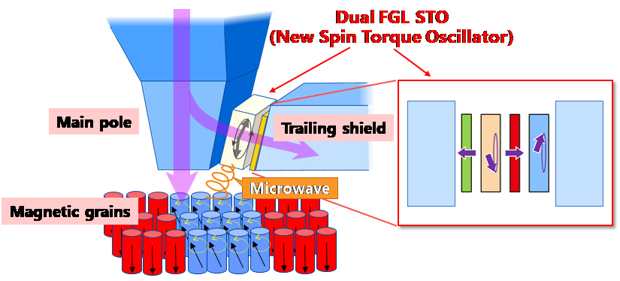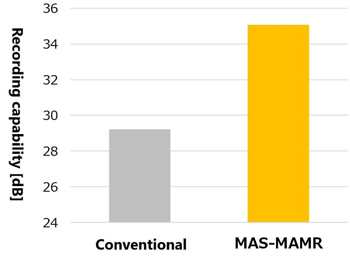Toshiba Demos Improvements in HDD Recording Performance With MAS-MAMR Technology
To realize early commercialization of nearline HDDs with capacities exceeding 30TB
This is a Press Release edited by StorageNewsletter.com on January 14, 2022 at 2:02 pmToshiba Group has announced the demo (1) of HDD recording performance improvement with Microwave Assisted Switching-Microwave Assisted Magnetic Recording (MAS-MAMR), a next-gen magnetic recording technology.
Fig. 1: Configuration of dual Field gen Layer Spin Torque Oscillator
(dual FGL STO) and its Oscillation Spectrum
The demonstration confirms that the technology delivers substantial storage capacity gains, and the company aims to realize early commercialization of nearline HDDs with capacities exceeding 30TB.
Tthe firm is placing R&D effort on MAMR, a technology that boosts HDD recording density. In 2021, the company started shipment of 18TB HDDs that apply Flux Control MAMR (FC-MAMR) (2), which uses spin torque oscillators to assist recording. MAS-MAMR is expected to improve recording density beyond that of FC-MAMR by locally exposing microwave to -recording media. However, this was not shown to be possible in practice until the recent demo.
Fig. 2: Improving Recording Performance with MAS-MAMR
Toward proving the superiority of MAS-MAMR, Toshiba has been promoting its development with Showa Denko K.K., an HDD medium manufacturer, and TDK Corporation, a HDD head manufacturer. This 3-way cooperation recently bore fruit in the demonstration of MAS-MAMR’s improved recording performance.
Toshiba will announce details of the newly developed spin torque oscillator and its oscillation characteristics at the Joint MMM-INTERMAG Conference 2022, an international conference scheduled on January 10-14, 2022.
Development background
Digital storage on data centers is a pillar of the modern information infrastructure supporting digitalization and digital transformation, and is now more important due to the Covid-19 pandemic. Continuing storage demand is on pace, and the market for high-capacity nearline HDDs, the workhorses of both cloud-scale and traditional data centers, is expected to grow to $ 17.5 billion in 2025 (3). This evolving needs for storage devices are also fueling demand for further capacity increases in HDDs.
Any attempt to increase the recording density of an HDD must reconcile a trilemma of 3 conflicting goals: miniaturize the magnetic grains on the recording medium; realize thermally stable magnetic grains; and secure sufficient recording performance. The recording medium is coated with a layer of fine magnetic grains that retain information according to the direction of their magnetization. While recording density could be improved by miniaturization of the recording bit on the recording media, this requires smaller magnetic grains, which reduces thermal stability of their magnetization. Loss of thermal stability may result in data losses.
Increasing thermal stability on increasing recording density requires a material with a higher coercivity that can maintain the magnetization. However, a higher coercivity makes it difficult for the recording head to generate the sufficient magnetic field for recording. Overcoming this requires next-gen magnetic recording technology in which recording is assisted by external energy.
Advances are being made in R&D of a next-gen magnetic recording technology to overcome this trilemma. While MAS-MAMR to assist using microwaves is expected to improve the recording density drastically in theory, the confirmation of microwave-assisted switching effect (MAS-MAMR effect) on recording condition and improved recording performance with MAS-MAMR have not yet been demonstrated.
Features of technology
The company has invented a‘bi-oscillation type spin torque oscillator device (dual FGL STO) that irradiates microwaves by a 2-layer field generating layer. The dual FGL STO generates microwaves efficiently, with less current and on focused spots. Incorporated into a recording head, it can improve recording performance with MAS-MAMR.
In the work to demo MAS-MAMR, TDK has developed new recording heads equipped with the STO, SDK has developed new recording media, and Toshiba has confirmed stable oscillation of STOs in the new recording heads.
Subsequently, Toshiba confirmed the MAS-MAMR effect by combining the newly developed STOs, recording heads and media, and for the first time demonstrated an approximately 6dB improvement in recording performance with MAS-MAMR (4). This technology makes it possible to realize HDDs with large capacity of over 30TB. By the demonstration, MAS-MAMR has taken a major step forward as a practical next-gen magnetic recording technology that can improve recording density.
Future prospects
The company now aims to realize early commercialization of nearline HDDs with capacities exceeding 30TB with MAS-MAMR technology. It will continue to develop MAMR technologies (FC-MAMR and MAS-MAMR) and to expand the capacity of nearline HDDs.
The firm will also continue to develop the Thermal Assisted Magnetic Recording (TAMR) technology in parallel, to meet a range of storage needs.
(1) Toshiba Research, as of December 24, 2021
(2) FC-MAMR: Flux Control MAMR. FC-MAMR is a trademark of Toshiba Devices & Storage Corporation
(3) Source: Techno-System Research Co., Ltd. HDD Market Trend (Annual), December 2021
(4) Evaluate the overwrite characteristic.
















 Subscribe to our free daily newsletter
Subscribe to our free daily newsletter

